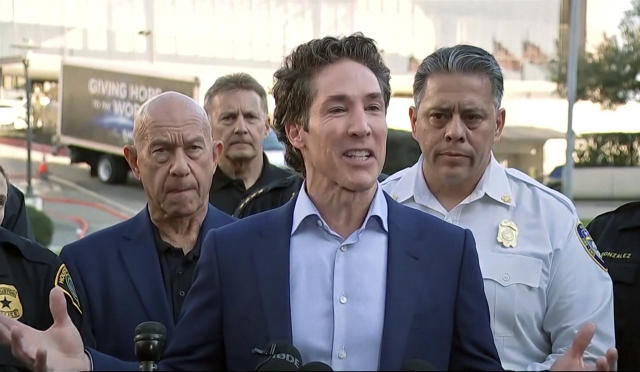
Joel Osteen is one of the most familiar faces in American religion.
The pastor who leads the Houston megachurch where a 5-year-old boy was critically wounded in a Sunday shooting that also hit a man in the hip — before the shooter was killed by off-duty police working security — is known for his megawatt smile, wavy hair and widely popular brand of Christianity.

The 60-year-old regularly preaches to about 45,000 people a week in a former basketball arena and he’s known to millions more through his television sermons.
Osteen inherited his calling from his father and increased the size of the congregation almost five-fold. His book, “Your Best Life Now: 7 Steps to Living Your Full Potential” sold nearly 3 million copies. In the mid-2000s, Osteen was viewed by more people than any preacher in the United States, reaching 95 percent of all households, according to Nielsen Media Research.
Authorities said the critically injured boy is the son of shooter Genesse Ivonne Moreno, 36, who authorities said had a history of mental illness, including being placed under emergency detention in 2016.
The weekend shooting at Joel Osteen’s megachurch in Houston is not the first time gunfire has caused panic and tragedy at a Texas house of worship.
Osteen told his 10 million followers on X, the social media platform, that his church community was “devastated.”
“In the face of such darkness, we must hold onto our faith and remember evil will not prevail,” Osteen stated. “God will guide us through the darkest of times. Together, we will rise above this tragedy and stand firm in our commitment to love and support one another.”
Decades before Sunday’s shooting, Osteen said he never dreamed he would be a preacher and never imagined leading a flock so large.
Osteen had never preached — and never had the desire, he has said — until the Sunday before his father died in 1999. John Osteen had founded the charismatic Christian Lakewood Church in an abandoned feed store in 1959.
Osteen told The Associated Press in 2004 that as his father’s church grew he preferred to be behind the scenes. He had left his studies at Oral Roberts University in Tulsa, Okla., in 1982 and joined his father’s staff as a television producer.
When the elder Osteen was hospitalized, the preacher’s son reluctantly stepped to the pulpit. His dad listened to the sermon by telephone from his hospital bed.
“The nurses said they’d never seen him so happy, so proud,” Osteen recalled in 2004. John Osteen died five days later, and his son “just knew it down on the inside” that God wanted him to preach.
Critics have taken Osteen to task for downplaying the sinful nature of humanity and the need for repentance. But Osteen’s mother, Dodie Osteen, told the AP in 2005: “We don’t preach the gospel sad, we preach it glad.”
“To me, it’s cotton-candy theology,” Ole Anthony, president of Trinity, a Dallas-based religious watchdog group told the AP in 2004. “There’s no meat. They just make everybody feel good.”
Osteen is “quite sincere,” said William Martin, a professor of religion and public policy at Rice University who lives near the Houston church.
Leave a Reply